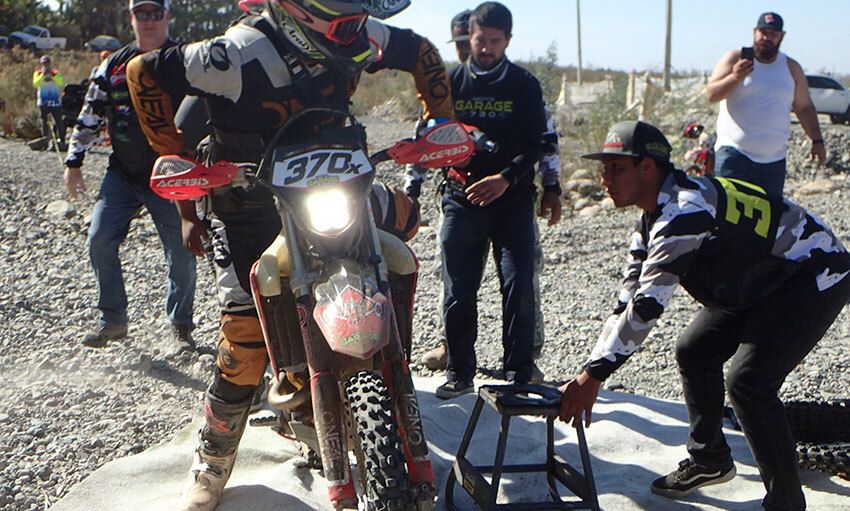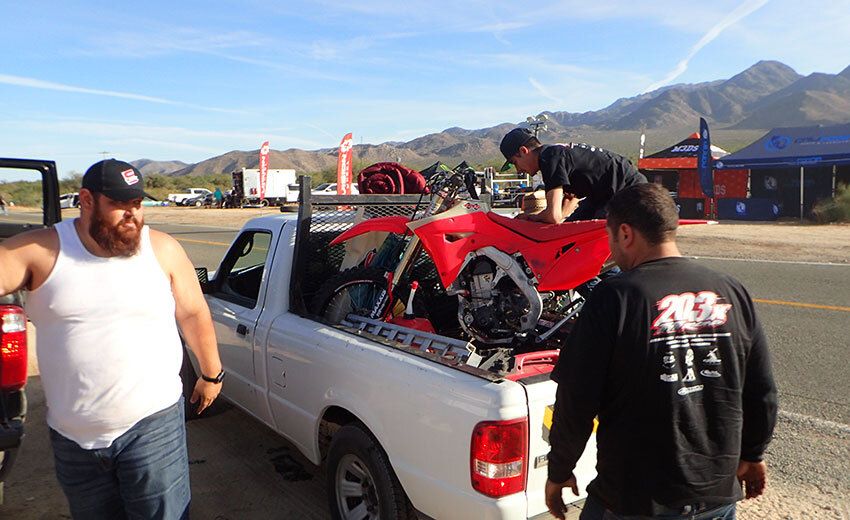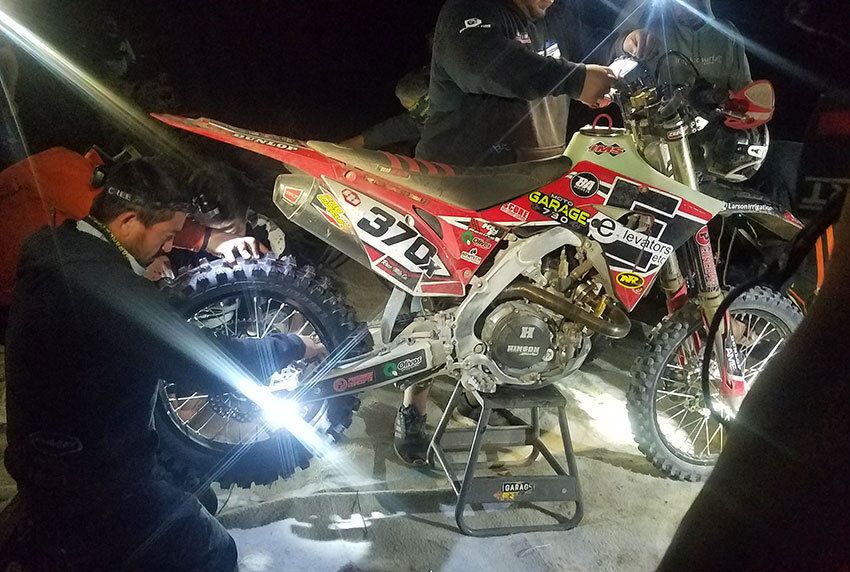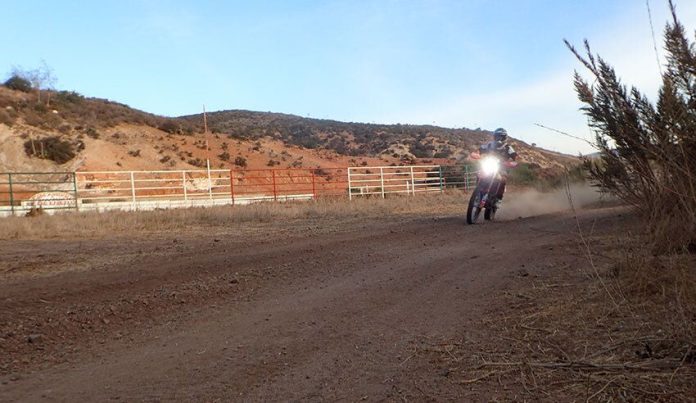It’s Thursday, November 19 on the eve of the Baja 1000. The streets of Ensenada are silent, save the usual hustle of daily life. But this year, there are no big crowds or vendors packing the streets with churros and colorful trinkets. It’s a ghost town. But while there may be no fanfare or crowds to cheer them on in this uncertain world of 2020, there’s one thing you can always rely on: racers will race.
Through the serendipity of the small world of racing, a friend had introduced us to Francisco Septian, owner of Moto Garage 730 and a local hero and multi-time winner of the Baja 1000, the Baja 500 and other off-road races. He invited us to join his chase team that would follow him and two other racers, Shane Esposito and Justin Schultz, in a couple of chase vehicles.
Ordinarily, the Baja 1000 has riders leaving Ensenada and barreling down to La Paz, over approximately 1,000 miles, but this year, because of Covid-19 restrictions, it was an 898.40-mile loop through the mountains of Baja California. This course was widely considered the most technically difficult to date and 187 entries from 14 countries showed up to meet the challenge.
The chase van arrived outside our hotel at 3 a.m. “Are you ready for 24 hours of craziness?” Francisco’s head mechanic grinned back at us.
Racers in the motorcycle and quad classes started at 4 a.m., released in one-minute intervals. Trophy trucks and UTVs gridded up at 10 a.m., giving riders a head start to gain a margin of safety. Having a 1200-horsepower trophy truck pass your motorcycle on a narrow road, kicking up rocks the size of your head, isn’t an ideal situation for a rider. This year, spectators, including the rider’s own team, were banned from the grid, so each rider launched into the dark unknown, their high-intensity discharge headlights blaring, to the quiet applause of a handful of officials. And then we were off. The crew ran to the van, loading up as quickly as possible, and peeled out onto Baja’s Highway 1.
Being in a chase vehicle is a race in itself. If you don’t get to each pit stop before your racer does, he will lose invaluable time that could cost him the race.

Our first stop was at a restaurant an hour from town. The mountains were dark silhouettes in the distance until the headlight of rider 1x lit up the mountainside. He descended the hills, then roared up a steep jump into the pit area. His bike bucked and slid its way onto the highway as quickly as it came. Moments later, to the crow of roosters under the pre-sunrise glow, our rider on 370x emerged from the trail. In a split second, Shane dismounted the team’s Honda CRF450X bike, Francisco hopped on and the crew swapped on the daytime headlight. With one last spin of a T-handle, Francisco began a six-hour marathon.
Having done many Baja races, Francisco pre-organized all of his pit locations. Everyone knew exactly where to go, where to set up, and what to do when the rider arrived. Any second lost could mean losing the race, so this took away all the guesswork. As soon as he was off, our van weaved through Baja traffic, taking the bonus lane past trains of semis and cutting red lights by skirting the road in the dirt. The regular world going on around the race continued to operate as if nothing were happening, but the racing teams were on the ride of their life.
Francisco slid both tires through a turn, threading a needle into a tunnel beneath the highway as his route crossed ours. On the next stop, his teammate tossed him his daytime goggles, amidst the glaring reflection of the desert sand. We followed the Pacific Coast to San Quintín, then the course hooked back north.
Six hours and 300 miles down, we set up in a quarry. The team avoided flying rocks as Francisco crunched through them and onto the mat. Within a minute, a new rear wheel was mounted. That’s when Shane took over, riding into the most challenging section of the course; we were back on the move.
While the next 100 miles could take as long as four hours, the next pit stop required a long haul over a twisting mountain pass of washboards. However, it was noon now, and every car in the Baja seemed to be out running errands. The lines of trucks were endless as our driver carved around the caravans, screeching tires through turns.

For hours, we twisted through desert hills, passing Picacho Del Diablo, the highest peak in the Baja. Each jolt to the suspension reverberated through my spine, but we couldn’t slow down. As we passed a small town, families stood outside their gates, jumping up and down and waving at every chase vehicle that drove by.
The Baja racers really are heroes here.
Our van barely arrived in time to meet Shane. He came barreling into the pit before they even had time to set up; perhaps this was partly because his front brakes had gone out. They swapped the air filter while Shane showed us the failed brakes. But with no way to fix it, he had to continue with only a rear brake to rely on. We followed behind him with our emergency flashers on, rolling at 60 kilometers per hour, the mandated speed for riders on all the paved motorways. It was all we could do.
Ten miles more down the road, we got a surprise: Francisco waved us into the dirt. Even on this level, racers never hesitate to help each other, and so another racer had offered us his spare Honda to use for parts. Within minutes, the master cylinder and brake lines were stripped from the parts bike, installed on the race bike and ready to go. Shane got back on, tearing into the course to make up time. Next stop: the Sea of Cortés.
The chase truck drove to the southern end of San Felipe’s loop, whereas our van went north. There wasn’t enough time to get from one pit to the next if we stuck together, so having two chase vehicles came in handy. The sun set behind us at mile 660 as we sat parked at the bottom of a sandy jump. Hundreds of people were set up on either side of the course, campfires burning, mariachi music blasting and laughter filling the air. We continued to wait.

Three hours passed. Still no sign of our rider. Meanwhile, the “weatherman” played over the radio, a channel where crew members can call for updates on their riders. That’s when we heard it: “370X-ray is stopped at mile marker 567.”
We pulled up live tracking through the Score app, made for fans to follow the Baja 1000, the Baja 500 and the San Felipe 250. On the app we could see that our rider was stopped, but no one knew why. As we continued watching, we realized he was veering off course: he was lost! But with no way to communicate, all we could do was sit helplessly and wait. A rider getting stranded out in the middle of the desert is a real risk, so much so that it’s required that riders bring enough food and water for a couple of days.
We lost a half-hour before he got back on course. But then he was blazing through the night at nearly 50 mph, making up for lost time. When he arrived, we got the scoop: a truck parked on the course had thrown him off track. The bike didn’t have GPS, and he had accidentally followed signs left standing from a Baja 500 race. When the tire tracks turned to cow tracks, he realized he was going the wrong way. Additionally, the brakes failed again, but with another parts bike, they swapped the entire brake system, and Francisco took over.
It was midnight when we arrived at the next stop. With 20 hours in, we had 200 miles left to go. At the fueling station, where Francisco eventually came skidding in, there was nothing wrong with the bike this time. Just one more stretch. The riders swapped, and Shane sped off. There was only one person he needed to pass to take the victory. We raced another hour down the road, just to make sure he was in good shape, but as he blasted by us within inches of the van, we knew he had it handled.
I fell asleep on the two-hour drive back to Ensenada. The whole van did. We pulled into Moto Garage 730 at 5:30 a.m. Shane rolled in shortly afterward with the elation of someone who had just finished 898.40 miles of one of the most intense, dangerous, and grueling races in the world. The total race time? 24:32.19.
At the end of the day, it’s not where you finish in the Baja that matters. It’s that you finished at all. Sure, everyone wants a coveted spot on the podium, but to simply stand on your own two feet, alive and successful after all those hours of rocks and sand and mishaps is the greatest victory of all. While I’m sure it’s nothing compared to the fanfare of prepandemic times, for the racers themselves it’s still every bit as satisfying.
But our team did take first in its class; so winning is pretty great too!
Mexico News Daily
